In Saigon, there are few notable tourist sites to visit outside of Chinese influences (the madcap market in Chinatown and some interesting temples there) or French influences (the wide boulevards and parks, the colonial buildings, the ornate fin-de-siecle General Post Office, and the knock-off of Notre Dame cathedral).
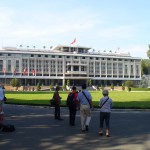
The most visited ones take you back 50 years to the early sixties and the decade of what they call here the American war. As an American seeing these, you wonder how you could be a welcome guest in the country after the destruction we brought to the villages and the environment. But we have found that the Vietnamese are a very forgiving people, and the reasons start to become clearer as you tour.

One of the main sites is the often renamed Reunification Palace which the U.S. sponsored government of South Vietnam turned into a presidential palace in the sixties, transforming the original French design into a sleek 60s moderne structure. It still looks as it did back then. Even the elegant furnishings have not changed, based on pictures taken at the time, and you see virtually intact where successive Presidents lived and worked and failed to win over the populace. Other pictures show the Viet Cong breaking down the iron gates as they took over Saigon in 1975, and that are now back in place. On the roof, you even see a helicopter they used to futilely visit the troops. Then, descending into the bunker-like basement, you wander through rooms filled with original equipment from that time: a Gates transmitter for radio broadcasts, antique telex machines, and a wide array of other massy tube-powered equipment. An army issue steel desk used by the leader in this bunker sits forlornly amid several maps charting the downward course of the war.
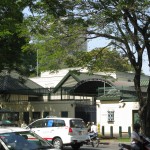
Just down the street sits the American consulate, the very same embassy that you know from the evacuating U.S. helicopters of the mid-70s…or Miss Saigon. With the same landing pad on the roof. It makes you wonder how the Vietnamese could forgive and forget, letting us right back into the same building years later. And how much things have changed when the people outside the consulate are lined up for visas to visit relatives in America, and that’s just OK with the leaders of the country.
Some answers come from the war and history museums, where the American involvement here and the sixties are placed in a broader perspective of a much older liberation and unification effort in Vietnam. It’s one they feel goes back to the 10th century, when the Khmer and Chinese occupied their land, and for a while the Mongols threatened it as well. It goes back to the Vietnam emirates that split north from south hundreds of years ago, and the civil wars of the 20th century. For nearly a hundred years, French colonialists took what they wanted here, then briefly the Japanese toward the end of the second World War, when the French reappeared. When the French were again kicked out in 1954, the big powers split Vietnam into the communist north and democratic south. To the Vietnamese, then, the U.S. was just the next colonizing force that needed to be overcome so the country could be whole and independent again.
Not that the communist leaders were all that enlightened either. When they reunified the country, they began a campaign against religion that resulted in the destruction of most Buddhist temples. They apparently victimized southerners who aided the Americans, so that many fled the country afterwards as well. In the 80s, time had healed and the country started to move on, with a freer attitude toward capitalism and progress, similar to China’s shift. By then the Vietnamese seemed to say, it’s time to move ahead, and embrace the possibilities of the future, not focus on the sins of the fathers on either side of the conflict. And not being so rigid about doctrine either. So now locals can talk freely about theirs being a socialist country akin to European ones, not a communist country. They can see a progression to a multi-party system. And they can see the gains – and losses – from development and progress.

Despite these changes, it’s still disturbing to visit the Cu Chi Tunnels about 40 miles outside of central Saigon. Fifty years ago this area was a stronghold of anti-American villages and a base for the Viet Cong forces infiltrating from the north. To avoid the bombings that rained onto them and to conduct their own guerilla war, the villagers and soldiers dug out this section of the hundreds of miles of tunnels and underground bunkers, three levels deep, that eventually spread up and down the country.
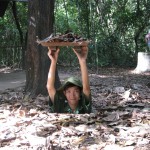
Of course, it does celebrate those who fought here. You start a visit with a contextual briefing in one bunker and then a scratchy propagandistic video celebrating the heroes of the resistance who confronted the “barbaric, aggressive American forces”. Gulp. You then wander the well manicured pathways through the forest and see the restored bunkers in which the villagers lived, studied, cooked, and communed. You also marvel at the frightening resourcefulness by which they hid entrances, air holes, vent holes for cooking, and so on.
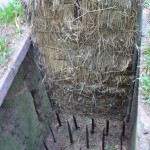
They tell us that American soldiers started using dogs to sniff possible entrances, so the Vietnamese started putting pepper spray around those to bother the dogs. Once the soldiers got wise to that, the tunnelers burned up GI clothing and spread the ashes near the holes so the dogs would not detect the locals’ scent. Tougher to see was their ingenuity in devising traps out of sharpened bamboo or swinging arrays of fish hooks that looked like medieval torture devices. Gruesome and chilling.

The bizarre thing about this place, now, is that today they’re all happy to see us visit. And the site has been turned into somewhat of an entertainment center. Guides that could be the sons or grandsons of the tunnel fighters show off pop-up tunnel entrances, demonstrate the grisly booby traps in desultory fashion, and switch on Disney-like moving figures hammering away to craft weapons out of unexploded American bomb parts. And you’re otherwise invited to, well, just enjoy yourself. Take a walk in the tunnels, now specially widened and deepened for visitors somewhat larger than the original fighters. Or fire off a few rounds with an AK-17 at the shooting range and cafe. As the brochure affirms, “Travelers shall have a good time, shopping souvenir products in fresh, cool air…or soaking in clear-blue water waves of a [separate] pool.”
Yes, it’s a relief to see how accepting and forgiving the Vietnamese can be, from then to now. Back then they kicked the American colonialists out of town. Now they’ve let us back into the same embassy building. And, like so many young people around the world, young Vietnamese consider America the model for material well-being and a higher standard of living. Back in Ho Chi Minh City/Saigon, for better or worse, you see that model in the billboards for costly products and from the expensive auto dealerships. You see it in the Colgate TV ads offering brighter smiles. You see it in the jeans look around town. You see it in the upscale restaurants known as KFC – where a meal costs an average person’s half-day’s wages – and outside of which you can see the colonel’s face grinning benevolently from blocks away.
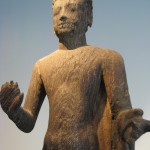
Even so, there are signs of a more balanced future for Vietnam, an interest in preserving the yin/yang balance so important in their belief system. You see it in the country’s Buddhist calm and all-embracing culture. Religion and reverence for elders is still important. In the midst of intense traffic and a more American-style pace of life, scheduling is a lot more flexible for them and most people stay intriguingly tranquil. Signs of a future far more hopeful than we could have imagined 50 years ago.
(For more pictures from Vietnam, CLICK HERE to see the slideshow at the end of the Vietnam itinerary page.)

